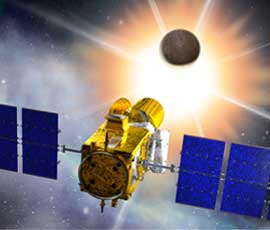
The CoRoT Satellite
The planet’s composition is not yet certain, but it is probably made predominantly of rock and water. Astronomers detected the new planet as it crossed the face of the distant "sun", dimming the star's light as it passed in front. This is known as the transit method. Professor Ian Roxburgh, from Queen Mary’s Astronomy Unit, who is a member of the CoRoT team, said the transit method still favoured the detection of big planets, because they blocked out more light from the parent star.
He commented: “If you had a small star - as this one is - then a moderate-sized planet would block out enough light to be detected by telescopes. There appears to be another planet orbiting the same ‘sun’, a Neptune-sized gas giant.”
The Corot mission is led by the French space agency (CNES), with contributions from Esa, Austria, Belgium, Germany, Spain and Brazil. Its main objectives are to search for exoplanets and to study the interiors of stars.
Most of the 330 or so exoplanets discovered so far are giant planets, primarily composed of gas, like Jupiter and Neptune. This new object, named CoRoT-Exo-7b, is very different. “Finding such a small planet wasn’t a complete surprise”, says Dr Daniel Rouan, from LESIA in Paris, who announced the discovery today at a conference in Paris. Dr Alain Leger from the Institut d’Astrophysique de Marseille, leader of the discovery paper, explains: “It could be an example of a so-called ocean planet, whose existence was predicted some years ago: a Neptune-like planet, made of ice around a rocky core, drifts so close to its star, the ice the melting to form a fluid envelope.”
The discovery of CoRoT-Exo-7b is being announced today at the CoRoT Symposium 2009 in Paris and will be the published in a forthcoming special issue of the journal Astronomy and Astrophysics dedicated to results from CoRoT.
CoRoT – which stands for Convection, Rotation and planetary Transits – was developed by the French Space Agency CNES, with important contributions from Austria, Belgium, Brazil, the European Space Agency, Germany, and Spain. It was designed to detect tiny variations in the luminosity of stars, with two scientific goals: searching for planets orbiting stars other than the Sun, and studying the internal structure of seismology.
